Key Posts Category
Boys’ Fiction: Ripping Yarns From The Victorian and Edwardian Heyday of Public School Fiction
AT last, a welcome repeat of Michael Palin and Terry Jones’s Ripping Yarns – post-Python parodies of all things public school and derring-do.

The series is reflected upon, and its inspiration investigated, in this highly enjoyable BBC documentary…
Read the rest of this entry »
Posted: 6th, April 2014 | In: Books, Flashback, Key Posts | Comment
Mic Wright’s Remotely Furious: A Harsh Handbrake Turn – From How I Met You Mother To How Tim Hetherington Lost His Life

Photojournalist Tim Hetherington, center, stands with other photographers outside the entrance to the hospital in Ajdabiya, Libya Sunday, April 10, 2011. Hetherington was killed in Misrata, Libya Wednesday, April 20, 2011 while covering battles between Libyan rebels and government forces. (AP Photo/Ben Curtis)
I’VE been thinking about bad endings this week; one in fiction and one, dreadfully, tragically real. Pulling together the finale of How I Met Your Mother, which used a by-no-means unexpected passing to tie up loose ends, and the real death of Tim Hetherington, the astounding documentary photographer whose life is the subject of Which Way Is The Front Line From Here?, in one TV column may seem crass. It probably is. But that’s how TV works, mashing together different stories, shifting tone more awkwardly than a local radio DJ.
If you were engaged in idle channel surfing, Sebastian Junger’s film on the life and death of Hetherington, his friend and collaborator on the Academy Award-nominated Restrepo, would have pulled you up short. Named after a casual remark made by documentary photographer as he and a group of other journalists made their way into the Libyan town of Misrata, the film paints a picture of a man who had to document the world and its most dangerous stories even when he knew he should stop.
Read the rest of this entry »
Posted: 4th, April 2014 | In: Key Posts, TV & Radio | Comment
Chicks Dig Accordions! Vintage Vinyl and Squeezebox Groupies

TO HELL with the electric guitar. That may attract a flock of dirty groupies, but the real chick magnet is the accordion. Sure, it has a reputation as being even less sexy than a French horn, but don’t believe the hype. A look at this stack of old accordion LPs, and you’ll quickly see that the instrument of desire isn’t the guitar, drums or microphone, it’s the mad love machine called The Accordion.
(Lots more vintage gold on Flashbak.com)
Read the rest of this entry »
Posted: 4th, April 2014 | In: Key Posts, Music | Comments (3)
5 Sci-Fi TV Series Scuttled by Second Season Changes

WE might accept as axiomatic the belief that patience is a virtue. However, over the decades, several notable and even celebrated science fiction TV series have failed to live up to this ideal.
Instead of demonstrating patience and prudence, their makers have instead demonstrated radical impatience, and — after promising first season sorties — instituted sweeping changes that, in some cases, threw away the baby with the bath water.
Read the rest of this entry »
Posted: 3rd, April 2014 | In: Flashback, Key Posts, TV & Radio | Comments (7)
1978-1995: When Theodore John Kaczynski Was The Heroic Unabomber
ON May 3 1996, Theodore John Kaczynski, 53, had his mug shot taken by7 the Lewis and Clark County Jail in Helena, Montana. Kaczynski had been taken into custody at his mountain cabin north of Helena as a suspect in the Unabomber bombing spree.

The man called the “Unabomber” had killed three people and maimed 23 others with parcel bombs. His first known device exploded in 1978 and the last, killing California Forestry Association president Gilbert Murray. His campaign had continued to his most recent bomb in 1995. His final bombs was his 16th.
Read the rest of this entry »
Posted: 3rd, April 2014 | In: Flashback, Key Posts | Comment
Before They Went Solo: Early Bands Of Bowie, Elton And Others

Billy Joel’s hard rock duo – Attila
MUSICIANS like Billy Joel and Elton John didn’t start out as solo acts. Like nearly all solo pop stars, they began as just another member of a band. I thought it would be interesting to take a look at musicians who we primarily identify as being solo acts and see what bands they were in before venturing out on their own and making it big.
Read the rest of this entry »
Posted: 3rd, April 2014 | In: Flashback, Key Posts, Music | Comments (2)
5 Sci-Fi Movies That Didn’t Deserve the Mystery Science Theatre 3000 Treatment

TO the delight of virtually everyone, the late, great Mystery Science Theater 3000 (1988 – 1999) seems to be experiencing something of a pop culture resurgence these days.
April 1st of this year saw former Mystery Science Theater 3000 stars Mike Nelson, Bill Corbett and Kevin Murphy return to top form in National Geographic’s Total Riff-Off, and the cable network Retro TV recently announced that it will begin airing MST-3K reruns starting July 5, 2014.
Read the rest of this entry »
Posted: 2nd, April 2014 | In: Film, Flashback, Key Posts, TV & Radio | Comments (13)
10 Revolting Packaged Foods That Taste Of Regret
STROLLING down Memory Lane on the way to Anorak Towers, we came across an old advertisement for Spangles – the sweet signifier of choice for lazy peddlers of nostalgia.
But instead of invoking it alongside Chopper bicycles and Spacehoppers, it invoked an earlier, less innocent time, when germs were everywhere, and the role of confectionary packaging wasn’t simply to announce the Old English delights within, but to keep dirt out. ALL dirt. Yes, that includes you, Foreign Dirt, coming over year and contaminating our indigenous flavours.

Read the rest of this entry »
Posted: 2nd, April 2014 | In: Flashback, Key Posts, The Consumer | Comment
Regrettable Reads: A Stack Of Objectively Bad Vintage Books

THEY say not to judge a book by its cover, but I think it’s pretty safe to say all of these books are horrible without ever turning a page. That being said, it’s sometimes fun to check out some good old fashioned paperback trash – so let’s have a look.
NAKED BRUNCH

Perhaps this is a prequel to the William Burrough’s classic, Naked Lunch. I suggest, then, a third volume called Naked Supper and make it a trilogy.
THE MAN WHO SAID NO

You mean they actually found the guy who said no to sex? I thought it was just an urban legend……. Oh, wait…. I’ve just been informed it’s a false alarm. He didn’t say “no”; he was merely clearing his throat. It’s all been a big mistake. False alarm.
RONALD REAGAN: A MAN TRUE TO HIS WORD

My favorite part of Ronald Reagan: A Man True To His Word is when the president sells arms to Iran then uses the cash to fund the Nicaraguan rebels. Don’t miss the exciting climax when he completely denies it.
INCLUDED OUT

“Suspecting Linnie’s affairs with the others, Chris’ vanity couldn’t accept the thought of being included out because of his age.”
I think the word they’re looking for is “excluded”. Somebody get Mary S. Gooch a dictionary pronto.
I WAS A TEEN-AGE DWARF

No offense to those short of stature, but this title puts the vertically challenged on par with being a werewolf or Frankenstein. (Note: This is a Dobie Gillis novel, so it was actually pretty popular in its day.)
KISS MY FIST!

Damn! Those hardboiled pulp fiction novels could get to be pretty brutal, but this is extreme. Just be glad I didn’t show you the back cover where he karate chops a kitten.
SWEET DADDY: THE STORY OF A PIMP
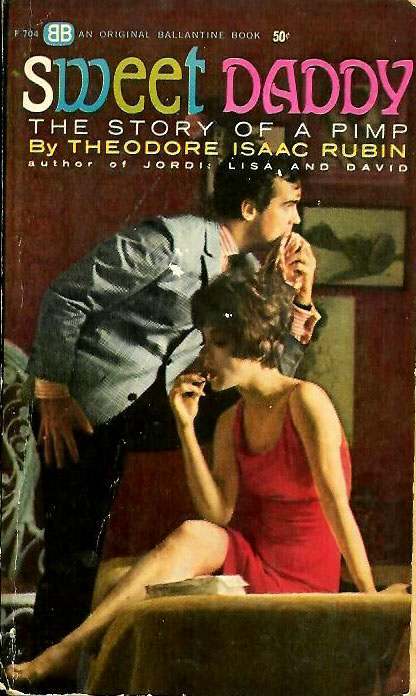
I think there’s been a mistake. The title should read something like: Sweet Daddy: The Story of a Tax Attorney. I’m no authority on pimps, but I think they could have chosen a guy who looks a lot more “pimp like”.
BURT REYNOLDS HOT LINE: THE LETTERS I GET AND WRITE!

I doubt Burt even noticed the naked woman attached to his backside. In the 1970s, nude females collected on Burt’s body like barnacles. Lucky bastard.
COUCH OF DESIRE

Forget 50 Shades of Grey, I recommend Couch of Desire (truthfully, it’s probably written better). But if the eroticism is just too extreme for your tastes, I suggest the much lighter read, Beanbag Chair of Friendship.
GOOD NIGHT SWEET DYKE

A perfect end to our reading list of shame. Good night, dear reader.
Posted: 2nd, April 2014 | In: Books, Flashback, Key Posts | Comment (1)
Spoonfuls of Horror: The Worst Breakfast Cereals Of All Time

THE worst cereal of all time, for me, has always been Grape-Nuts (AKA aquarium gravel). Yet, as I grew older, I actually came to like these granular pellets which look like they belong at the bottom of a fish tank. Tastes evolve.
I say this to underscore the fact that this list is purely subjective. Yet, it’s still fun to poke through the vast arrays of breakfast cereals from years past and single out the worst of the worst. I apologize up front if I am besmirching your cherished childhood favorite, but it simply must be done. And so here they are – the definitive list of the absolute worst breakfast cereals of all time (in no particular order). Enjoy.
1. Triple Snack (1963)
I’m not sure about the idea of roasted peanuts in cereal. Almonds are fine, but you start tossing roasted peanuts into the mix, and things get weird.
2. Pink Panther Flakes (1973)
The corn flakes were bubblegum colored, which is bad enough, but the cereal became notorious for rapidly losing its color. Almost as soon as the milk hit the flakes, the bubblegum color ran off, leaving behind soggy albino flakes. Your breakfast started so full of promise, with the brilliant pink hue signaling good tidings ahead. Fast forward a few seconds, and you’re eating your soggy albino flakes in quiet disappointment.
3. Donkey Kong (1982)
The taste was not bad; it was the texture that presented problems. Many will recall the “barrels’ scraped the roof of your mouth like a mouthful of broken glass. To be fair, after repeated spoonfuls, your throat and mouth would swell and become inflamed enough to no longer feel the sharp pain. So, enjoying the cereal wasn’t entirely impossible.
4. Punch Crunch
“Little pink rings with a big pink flavor just like fruit punch… a dandy part of a nutritious breakfast.”
At what stage of desperation do you have to be in to attempt a punch flavored cereal? Was Captain Crunch suffering from scurvy when he concocted this vitamin C inspired cereal? It would seem to be the only rational explanation.
5. Sir Grapefellow (1972)
There are just certain flavors that don’t belong in a cold milk cereal. Thus, as much as we may happen to like bacon and pizza, it doesn’t mean they will make for good cereal flavorings. Someone should have told General Mills that grapes fall into that same category.
6. Corn Flakes with Instant Bananas (1964)

This one was discontinued in ’66 due to problems with the preservation and freeze drying of the bananas. Apparently, Kellog’s hadn’t yet perfected the fancy carcinogenic preservatives and dyes we all take for granted today. Upon the addition of milk, the “bananas” turned into shriveled bits of brown before your very eyes. Had the box prepared consumers and perhaps been labeled “Corn Flakes with Shriveled Bits of Brown” instead, things might’ve been different.
7. Smurf Berry Crunch
Aside from the fact that many recall a distinct iodide smell, the primary problem was what happened after it was consumed. Evidently, Smurf Berry Crunch turned your poop a brilliant purple. While that may have been a “plus” to many consumers; for most, violet poop was an unwanted side effect.
8. Norman (1971)

Very little information remains beyond first-hand accounts. Most will tell you that this BUTTER flavored cereal was the most revolting thing they’ve ever eaten. It basically amounted to small crunchy butter flavored balls which in no way went nicely with cold milk. Those unfortunate enough to have experienced this breakfast horror tell the story as one would recount a grisly battle – with hushed somber tones, a vacant stare, and an expression that belies the tragedy of it all. Our deepest respect to the poor souls who took a spoonful of Norman to their lips and lived to tell the tale.
Posted: 1st, April 2014 | In: Flashback, Key Posts, The Consumer | Comments (6)
David Hasselhoff Sells Huge Statue Of Himself Dressed As A Lifeguard (Photos)

DAVID Hasselhoff is so rock and roll. And now you can roll him into your room and rock him gentle as you straddle his back and surf along to his greatest hits as a woman in red tosses salty water in your face. You see, David Hasselhoff is selling a David Hasselhoff statue he owns at a Beverly Hills auction.
This is the Hoff who, when appearing in panto with dancing Louis Spence gave him the gifts of “A David Hasselhoff bag, Hasselhoff CD, Hasselhoff calendar and signed Hasselhoff picture” for Christmas. This is the Hoff, the man who brought down the old fault line of Europe by standing on the Berlin Wall dressed in a suit of lightbulbs, a performance of which he said: “I went to the Checkpoint Charlie museum a few years ago. There was nothing of me, and I was disappointed. Look at all these people celebrating! What about me? I was there!”
Read the rest of this entry »
Posted: 31st, March 2014 | In: Celebrities, Key Posts, The Consumer | Comment
Miracle Appliances And The Desperate 1970s Women That Loved Them
WHEN mankind emerged from the primordial ooze that was that was the 1940s, homes began a rapid upgrade. The Western nations’ economies grew in tandem with technology, and the benefits began to enter the home in the form of appliances that promised to transform the household. Now you could own a toaster – oh, the possibilities!

Read the rest of this entry »
Posted: 31st, March 2014 | In: Flashback, Key Posts, Technology, The Consumer | Comment (1)
Watch The Blight: A Wonderful Documentary On Glasgow’s Barrowfield Gang Lands In 1982
GLASGOW has a tough reputation. In 1982, the BBC documentary department went on safari in Glasgow, reporting on the city’s gangs.
The show focused on the Barrowfield is an area of east Glasgow in Camlachie, close to Celtic Park, home of Celtic Football Club.
The study on urban decay and life was split in four parts:
BLIGHT, WORK, THE SCHEME and THE BOND.
Read the rest of this entry »
Posted: 30th, March 2014 | In: Flashback, Key Posts, TV & Radio | Comment (1)
Darren Gough’s Greatest Moment on TalkSPORT: ‘We H’all Live In A Yeller Sumbarine’
DARREN Gough was once a cricketer with Yorkshire and England.

Gough was both talented and likeable. The top English bowler of his generation retired from professional cricket. And Barnsley’s favourite Tory hit even greater heights.
Read the rest of this entry »
Posted: 28th, March 2014 | In: Key Posts, Sports, TV & Radio | Comment
Exploring the IMDb Bottom 100: The Worst of The 1960s
WITH nearly 3 million films in their database, it’s quite a dubious accomplishment to be ranked in IMDb’s Bottom 100. That’s the bottom of a very deep barrel – the bottom 0.003% in fact. I’d love to explore all the members of this exclusive club; but, in the interest of time we’ll start with the 1960s.
The 2000s are the most represented decade with over 40 films in the Bottom 100. At the moment there are 12 from the Sixties: Santa Claus Conquers the Martians (1964), The Beast of Yucca Flats (1961), The Incredibly Strange Creatures Who Stopped Living and Became Mixed-Up Zombies!!? (1964) and these 9 truly awful films (proceed at your own risk):
Monstrosity (1963) AKA The Atomic Brain
IMDb rating = 2.5

An elderly woman hires a mad scientist to transplant her brain into that of a nubile young au pair girl. Somehow this is done without surgery using only the mysteries of radiation. The only way this film could get any worse would be if it starred Adam Sandler.
“Mrs. March had not realized her future body had such a satisfactory shape. Perhaps not as spectacular as the English girl but in excellent taste. She couldn’t help being amused. The stupid girl was not only modeling Mrs. March’s future wardrobe but Mrs. March’s future body: so firm, so nicely round in places men like.”
As luck would have it, some of these films have fallen into public domain, and now you can watch the whole thing for free (the only price you’ll pay is your sanity).
Monster a-Go Go (1965)
IMDb rating = 2.5

The movie begins with the narration: “What you are about to see may not even be possible, within the narrow limits of human understanding.” Oh, how painfully true.
This is the only film in this entire list that defies description because there is literally no plot. It is one random scene after another, with main characters inexplicably leaving midway through the film never to return, and with a twist ending that even M. Night Shyamalan would be ashamed of.
The Starfighters (1964)
IMDb rating = 2.4

There’s a miserable little plot in here somewhere, but this film is basically just stock footage of aircraft lazily pieced together. In fact, there are several – I repeat, SEVERAL – scenes of airplanes refueling… in real time, without edit. It may not have earned the honor of being IMDb’s absolute worst, but it is likely the most boring film in the entire database. When a plane refueling is the highlight of your film, there’s a problem.
For wondrous refueling footage, watch the clip below, but beware of the mind-numbingly infectious “Doo Wah” background music.
Body in the Web (1960) AKA Horrors of Spider Island
IMDb rating = 2.3

“There’s absolutely no reason yet to fear the worst. Until now, we only know that the plane caught fire and we’ve lost radio contact.”
I appreciate his optimism, but that seems like bad news. Indeed, the plane crashes and a troupe of beautiful dancers are stranded on a deserted island. Their routine of skinny-dipping and devising new skimpy outfits is interrupted when a radioactive spider bites their manager and turns him into the dumbest looking monster ever. Recommended for the vision and hearing impaired only.
Eegah (1962)
IMDb rating = 2.1

There’s a serious debate in the film community about whether Arch Hall, Jr. is the worst male lead in the history of cinema. In other words, of the approximately 3,000,000 films in IMDb, the esteemed Arch may officially be counted as the absolute worst. I think Crow from Mystery Science Theater 3000 said it best: “I’ve figured it out. He’s a cyst with teeth and hair.”
Girl in Gold Boots (1968)
IMDb rating = 2.1

A girl with a more than passing resemblance to Angelina Jolie goes from waitress to center-stage go-go dancer. Think Showgirls (1995), but with no gratuitous nudity to redeem it. To quote a reviewer on IMDb: ‘This movie is a big, steaming pile of continuity errors and bad acting.” Truer words were never said.
The Wild World of Batwoman (1966)
IMDb rating = 2.1

The IMDb synopsis pretty much covers it:
A busty Batwoman enlists her beauteous bevy of Batgirls (when they are not dancing the jerk) to help her regain a mad scientist’s invention (an atom bomb made out of a hearing aid) before a costumed ne’er-do-well, Rat Fink, can glom onto it for his own purposes.
Invasion of the Neptune Men (1961)
IMDb rating = 2.0

Again,IMDb explains it best:
A bunch of kids who look like rejects from the Japanese version of ‘Lord of the Flies’ run around while aliens (from Neptune, presumably) blow up stock footage, including a building with a giant mural of Adolf Hitler. After much technobabble and shots of radar displays, they are defeated by a wispy bachelor named Space Chief who has a wobbly flying car.
Manos: The Hands of Fate (1966)
IMDb rating = 1.9

A family gets lost and winds up staying with this creepy midget, Torgo, and his caped master who worships the deity Manos. Like most people who’ve seen this film, I came by it via Mystery Science Theater 3000. The plot itself is terrible, but what makes this rock bottom is an almost preternaturally awful execution.
Posted: 28th, March 2014 | In: Film, Flashback, Key Posts | Comment (1)
5 Movie Maniacs From The 1980s That Wanted To Be Freddy Krueger
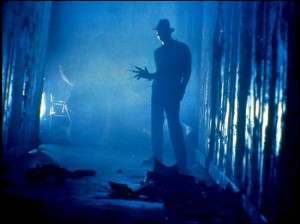
THERE’S an old saying that goes: “if you’re going to take a shot at the king, make sure you don’t miss.”
Such words of wisdom also apply to the movie monsters of the 1980s.
Thirty years ago, in 1984, Wes Craven’s “bastard son of a hundred maniacs,” Freddy Krueger (Robert Englund) rose up to become the reigning king of the horror film with the theatrical release of A Nightmare on Elm Street. The Gloved One took New Line — “The House That Freddy Built” — straight to the top with him.
Read the rest of this entry »
Posted: 27th, March 2014 | In: Film, Flashback, Key Posts | Comments (2)
I Was At Diana Dors’ Sex Parties: Max Clifford, Bob Monkhouse’s ‘Slit Eyeballs’ And The Krays

DIANA Dors is in the news. When the tittering had died down in court, Max Clifford told the jury in his sex crimes trial that he attended “sex parties” hosted by the actress Diana Dors. Mr Clifford denies 11 counts of indecent assault against seven women and girls.
Dors was one of the country’s biggest stars. Dors was billed as Britain’s Marilyn Monroe.
Her real name was Diana Fluck – but her mother said she should change it because there was always the chance that her name would be up in lights outside a cinema – and one of the letters might fall off.

And she had hosted sex parties at her Orchard Manor home in Sunningdale, Berkshire.
* It really is terrifying how gullible and naïve I was and still am,” she confessed to author Clive Hirschhorn in 1968. “I fell for hard-luck stories the way boys fall for girls. To make things worse I surrounded myself with gangsters, conmen and phoneys!”
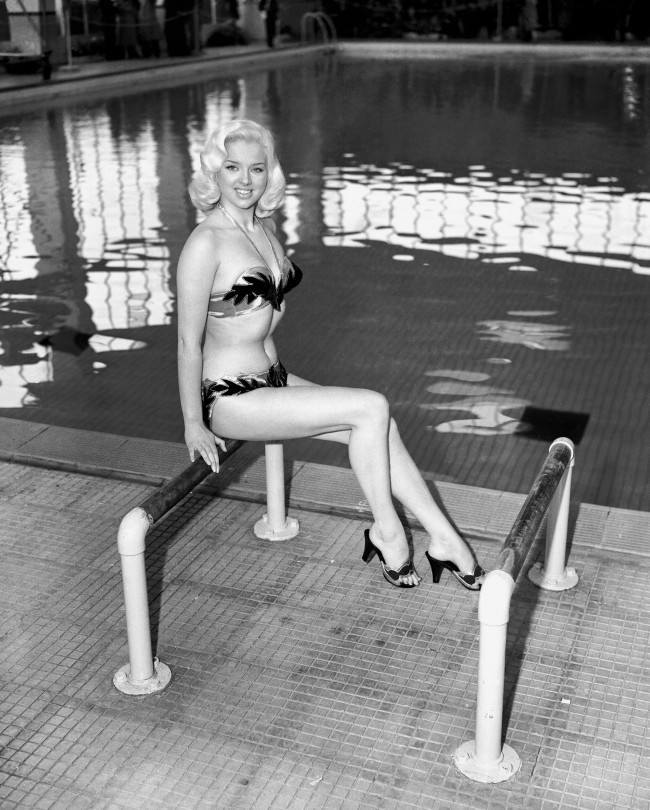
Actress Diana Dors, in her early twenties, during the filming of “Value For Money” in 1955.
She had a turbulent love life.

19 year old film actress Diana Dors and her new husband Dennis Hamilton, 26 year old representative of an engineering firm, leaving Caxton Hall register office after their wedding. Date: 03/07/1951
Rob Baker takes up the story.
She married her first husband, Dennis Hamilton, at 4.pm 3rd July 1951 at Caxton Hall registry office in Westminster. She was just nineteen and already a film star. Her parents, not over-enamoured with the proposed union, decided not to come, and Diana, who was still under the, then, legal age of 21, had to forge their signatures on the form that gave permission for their daughter to be married.

Film star Diana Dors, who has filed a divorce petition against her husband, Dennis Hamilton, pictured with actor Tommy Yeardye before they left London Airport for Rome. Date: 02/07/1957
The Caxton Hall wedding between Diana Dors and Dennis Hamilton wasn’t the smoothest of affairs. Before the ceremony the couple had posed for pictures outside (Hamilton had tipped off the press) but eventually the registrar tapped Hamilton on the shoulder and asked for a quiet word. The official discretely told him that he had received an anonymous phone call with the information that the marriage application had been forged.
Hamilton, furious, grabbed the registrar by the throat and shouted: “You’ll marry us, all right, or I’ll knock your fu*king teeth down your throat.”

They had met just five weeks previously after Dennis had chatted Diana up when asking her for a light. She was instantly charmed. Although Diana already had a boyfriend, a man of dubious morals named Michael Caborn-Waterfield, Hamilton sent her flowers almost daily. Unfortunately, Michael went to prison for a fortnight after one too many shady business deals and Dennis pounced. He proposed to Diana at the end of June 1951 and they became Mr and Mrs Hamilton just four days later.
Dors was in the middle of working on a film called Godiva Rides Again [see photo above] so there was no honeymoon after the wedding, just a meal in Olivelli’s in Store Street. The guests all paid for their own meals.

At home in 1960
Said Maxwell:
“There would have been parties from my younger days when I was friends with Diana Dors because Diana had parties. hey were not orgies. Not everyone went there and took their clothes off.”
The sex parties became a feature of her life from her first marriage.
By the time of her wedding she had already been a contract girl for J Arthur Rank for five years and had made some fifteen films including a role in David Lean’s Oliver Twist.
She was certainly not untalented but had always struggled to find real noteworthy roles and a rather turbulent private life certainly didn’t help her cause. She had been renting a small flat off the Kings Road from 1949 for six guineas a week but was eventually thrown out after complaints from the neighbours for the endless parties, late nights and loud music. The nights must have been very late and the music very loud because she wrote in her first autobiography in 1960:
“I didn’t realise it but the cute flat was slap dab in the middle of one of the worst areas I could have established myself in, for Chelsea in those days, just after the war, was much wilder than it is today.”
In 1950, while seeing Caborn-Waterfield, she also had a traumatic illegal abortion, performed on a kitchen table in Battersea, for ten quid.
The ‘interesting’ private life didn’t disappear now that she was married to Hamilton. Not long after their wedding he introduced her to, what were basically, sex parties.

Just a few months after Diana and Dennis’s wedding, Bob Monkhouse, then a 24 year old up-and-coming script writer, was invited to one of their parties. The lights were very low when he got there with almost the only lumination coming from a 16mm projector showing hard core porn (stag films or blue movies as they were known then) and there was a faint smell of Amyl Nitrate in the air.
Monkhouse was quickly invited to bed by a very attractive and comely young dancer. It was a little too quickly and he soon realised that something wasn’t quite right. After his eyes adjusted to the darkness he saw that there was a false mirror on the ceiling and the other party guests were watching behind it. Furious, he stormed out of the room, with the ‘dancer’ shouting, “I think he’s a homo”. He was met by Dors in the hallway who said:
“Some people absolutely adore putting on a show, they come back to my parties just to do that.”

Scriptwriter and comedian Bob Monkhouse with his family, wife Elizabeth, son Simon (centre behind), and adopted daughter Abigail, in their St John’s Wood home in London. Date: 23/02/1962
The following year Monkhouse and Dors met again at a Sunday evening radio show and they had a brief affair. Diana lied that her husband was in New York to lower Monkhouse’s guard. Eventually Hamilton found out about the affair and threatened Monkhouse with a cut-throat razor screaming at his face:
“I’m going to slit your eyeballs!”
Monkhouse only escaped by kneeing Hamilton in the groin and running away, but he once wrote that he had spent the next six years continually looking over his shoulder. He only had to worry for six years because in 1959 Dennis Hamilton suddenly died. His death was initially blamed on a heart attack but the day after the funeral Dors found out that he had died of tertiary syphilis. It never came to light, despite many autobiographies, whether she had contracted the disease herself.

Head of the panel of judges, Bob Monkhouse gives a hug to 23-year-old Eileen-Elizabeth Sheridan of Walton-on-Thames, Surrey, after she had won the title of Miss Great Britain, at Morecambe, Lancashire. To their right is runner up Barbara Smith,23, of Walthamstow, London. Date: 01/09/1960
Her career floundered:
Diana Dors made one acclaimed film in the fifties called Yield To The Night – a movie that was loosely based on the Ruth Ellis story but it’s not entirely unfair to say that she starred in some of the worst films ever made. After an unsuccessful foray to Hollywood (a public affair with Rod Steiger and and an incident where Hamilton beat up a photographer unconscious didn’t help), her film career, despite the very early promise, never really took off.

Dors would later complain that while Marilyn Monroe was making How To Marry A Millionaire in Hollywood, she was up in Manchester making It’s A Grand Life with the alcoholic northern comedian Frank Randle. Diana Dors was always a household name but it was her television guest appearances and roles in saucy sex comedies such as The Adventures of a Taxi Driver and Swedish Wildcats, that eventually kept her in the public eye.
She became the diet guru on GMTV in 1983 – where apparently she would weigh herself with all her heavy gold jewellery so it would look like she lost weight the following week. She died of protracted cancer the following year in 1984.

British film femme fetale, DIANA DORS, 37 holds her five-day old baby son, JASON LAKE in her bed at a Welbeck Street nursing home in London today (Monday). Diana’s third husband, Alan Lake, 28 is the father of Jason. Diana has two other sons, Mark, 10, and Gary, 7. They live in Hollywood with their father Dickie Dawson. Date: 15/09/1969
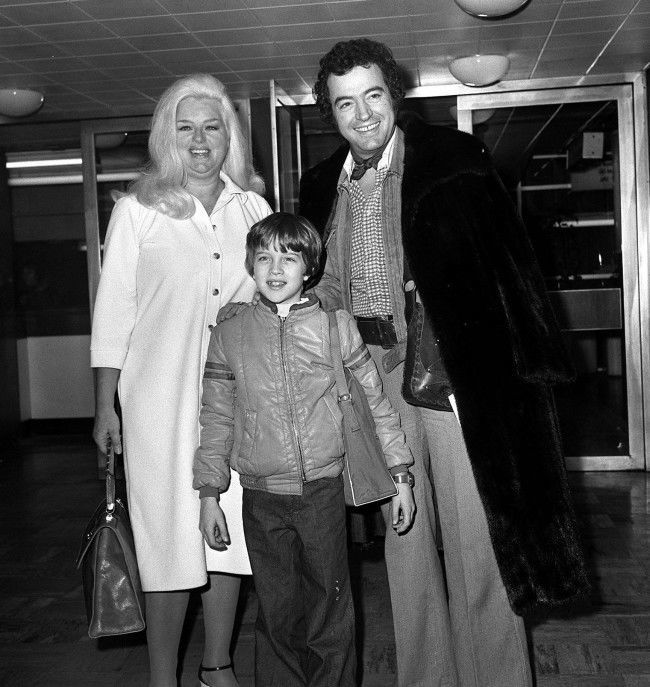
Off to Hollywood, California from London’s Heathrow airport today, are actress Diana Dors, her husband, actor Alan Lake, and nine year old son Jason. Alan who feels the cold, wears one of Diana’s own Christmas presents – a full length mink coat. In America, Miss Dors will visit her grown up sons and appear on TV chat shows. Date: 28/12/1978
Her son Jason Lake would recall:
“My Dad [Alan Lake] used to get drunk with Richard Harris and Oliver Reed. I’d come back from school and they’d all still be in the living room talking rubbish with the room smelling of cigarettes and alcohol. Lionel Bart had a cocaine habit, so he’d get trashed. I remember him coming out of the loo with cocaine all down his sleeve and Oliver Reed and Dad having sword fights on the lawn.”

With a large ring on her engagement finger, actress DIANA DORS is pictured in London to-night (Monday) with 27 year old actor ALAN LAKE, from Stoke-on-Trent, whom she is to wed. Date: 28/10/1968
* “There were no taboos in our house. I was only seven but I was free to wander in and out of my mum’s parties, no matter how hot they got. I would walk around in my pajamas chatting to John Lennon and Keith Moon. Mum would wander around serving cups of tea and trying to get people up into the bedrooms. She loved having friends round to watch the porn films made at the parties. They would sit around giggling as couples groped each other and made love on the bed. Most of them didn’t even know they had been filmed.”
Lake and Dors acted together.

Diana Dors and her husband Alan Lake together for the first time on the stage, are seen in ‘Three Months Gone’ which opens at the Royal Court Theatre on Wednesday. Date: 26/01/1970
At home, sex was a commodity:
“It was a more up-to-date version of the two-way mirror. Some of the girls were wise to it. Mum just said: ‘This is what happens’, and I thought it was completely normal.’ Diana got her kicks by watching others having sex and procuring young women for famous men.
* Dors… admitted in a series of newspaper interviews to hosting sex parties at her home in Berkshire attended by celebrities including Bob Monkhouse. Guests would be encouraged to have sex with aspiring young actresses and Dors’s son Jason Lake alleged that the bedrooms were rigged with 8mm movie cameras and that his mother would enjoy watching the films later.

Diana Dors performing at Country Cousin. Date: 09/11/1978
Naturally, she knew The Krays.

Actress Diana Dors arriving with husband Alan Lake (right) and actor Andrew Ray (centre) at Chingford Old Church today for the funeral service of Mrs Violet Kray, mother of the Kray twins, two of London’s most notorious gangsters. The twins, Ronnie & Reggie, were brought from prisons where they are serving life sentences for murder for the funeral. Date: 11/08/1982
We’ve nothing to add about Maxwell’s trial, other than that he maintains his innocence.
The man who made a fortune with selling kiss ‘n’ tells about the great and good to the newspapers may take some of the stories he knows to his grave.
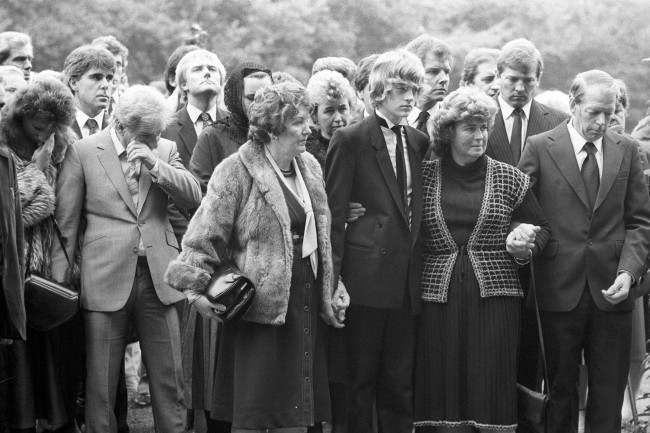
Wiping away a tear (l) is comedian Freddie Starr and his wife Sandy at the requiem mass of actor Alan Lake at the Sacred Heart Catholic Church in Sunningdale. Picture behind Freddie Starr is Max Clifford. Date: 17/10/1984
Adam Curtis has a nice aside about how Dors was tabloid gold:
The News of the World was in trouble – it’s circulation was falling. Part of the problem was television, but also its tradition of titillating court reports – randy vicars caught with their trousers down – was feeling tired and out of date. So early in 1960 Sir William Emsley Carr, the alcoholic proprietor of the News of the World appointed a new editor called Stafford Somerfield.
staffords
On his first day as editor, Somerfield called his staff together and – as he described it – “pushed the boat out”.“What the hell are we going to do about the circulation? It’s going down the drain. We want a series of articles that will make their hair curl.”
In a brilliant book about the British Press, the writer Roy Greenslade describes what Somerfield introduced – “two new forms of provocative content: kiss-and-tell memoirs and saucy investigations”
And right away he found the perfect combination of these in Diana Dors.
Somerfield persuaded her to tell the intimate secrets of her life in a series of articles for the News of the World. He had been fascinated by the Yeardye – Hamilton guns and sex drama and was convinced there was far more to be mined from her life. To get the story he paid Diana Dors £35,000 which was an extraordinary amount for that time.
But he got what he wanted. He sat Dors down with a journalist who recorded everything – and then, as Dors later plaintively complained, took “all the mucky bits” and wrote the story of a scandalous, violent and seedy life.
Ends.
Posted: 27th, March 2014 | In: Celebrities, Flashback, Key Posts, Reviews | Comment
The Darrin Factor: 6 Upsetting TV Character Replacements

IT shouldn’t be a big deal when a familiar actor or actress is abruptly replaced on a TV show. Yet audiences are often unable to cope. I suppose it’s due to the fact that a subconscious connection is often developed between audience and actors. When, suddenly, an interloper appears in his or her place, all hell breaks loose.
The textbook example is Darrin from Bewitched: when Dick York was replaced by Dick Sargent audiences were left confused and disoriented. What happened to Samantha’s husband? Did she remarry, or did she magically transform his physical appearance? What in the name of all that is holy is going on?!?
The problem is compounded when the original character was particularly beloved. Audiences got used to the “New Darrin”, but sometimes the shoes are just too hard to fill. Here are a few examples of when replacements had a particularly tough time filling in. Television audiences are an unforgiving lot.
THREE’S COMPANY
Jenilee Harrison (as Cyndi Snow) replaces Suzanne Somers (as Chrissy Snow)

Somers, in a mad grab for cash, demanded more money and the network execs dropped her like a bad habit. The very nature of the show demanded that there be a third roommate. Enter Jenilee Harrison, a Los Angeles Rams cheerleader with no acting experience. Not surprisingly, it was nothing short of an abject failure. The following season, Jenilee was let go, and Priscilla Barnes (as Terri Alden) took over for the final seasons (1981-1984). Priscilla succeeded where Jenilee could not primarily because she didn’t play a similarly imbecilic character, but had a good head on her shoulders. However, nothing ever captured the magic of Suzanne Somers – “jiggle TV” at its finest.
THE AVENGERS
Linda Thorson (as Tara King) replaces Diana Rigg (as Emma Peel)

In season six of The Avengers, Linda Thorson replaced Diana Rigg (a replacement herself). It would prove to be the show’s last season. American audiences didn’t seem to care, and French audiences actually preferred the replacement; however, British viewers would have no part of the change. Linda was roundly thrashed by the press as being a poor substitute – all looks and no brains, a damsel in distress rather than a strong heroine.
Some of the criticism was well-founded – Linda was very inexperienced as an actress and she got the part because she was the girlfriend of then-producer John Bryce. However, I think it’s clear the criticism was pretty unfair. Linda did a respectable job, and the show was already slipping before her arrival. I’m not sure who could’ve replaced Rigg and saved it. The show failed because it became dependent on US audiences, and it was lined up against Laugh-In (a show which also killed Star Trek).
Finally, it should be noted that Season 6 was actually an IMPROVEMENT over the previous season. Few will argue that Rigg’s last season was lame – it was becoming a spoof like Batman. In the final season, things started to get back to being serious.
CHARLIE’S ANGLES
Cheryl Ladd (as Kris Munroe) replaces Farrah Fawcett (as Jill Munroe)

It’s hard to comprehend what a phenomenon Farrah had become after her single season on Charlie’s Angles. Her shoes were impossible to fill, and it’s a testament to the likeability of Cheryl Ladd that the show survived. Far from being mortally wounded, the show strolled along for four more seasons…. but it just wasn’t the same. Even though Farrah was only there for the first season, when you think of Charlie’s Angels, you think of the Farrah year.
Certainly, there were other shows which lost a star but kept on truckin’: Welcome Back, Kotter lost Vinnie Barbarino (John Travolta), Alice lost Flo (Polly Holliday), M*A*S*H lost Trapper John (Wayne Rogers) and Lt. Colonel Henry Blake (McLean Stephenson), etc. However, those were shows that lost actors and actresses. Charlie’s Angels was a show that lost an icon.
CHICO AND THE MAN
Gabriel Melgar (as Raul) replaces Freddie Prinze (as Chico Rodriguez)

I will go on record and say that Freddie Prinze is among the top five stand-up comedians of all time. You’re certainly free to disagree, but there was just something truly special about his presence on stage. None of the jaded, cynical, self-deprecating stuff we come to expect from today’s comics. His was pure optimism and energy… which makes his 1977 suicide all the more unfathomable.
One thing I think we can all agree on is that Chico & the Man should have ended with Prinze’s death. The very notion that they would try and keep the sitcom rolling blows the mind. Poor Gabriel Melgar, recruited to fill the void, simply never had a chance. It was an awful idea that ended with predictable results – abysmal ratings and cancellation.
THE DUKES OF HAZZARD
Byron Cherry and Christopher Mayer (as Coy and Vance) temporarily replace Tom Wopat and John Schneider (as Bo and Luke Duke)

Dukes of Hazzard audiences tuned in to the new 1982 season only to find their beloved Bo and Luke Duke replaced by obvious clones. Schneider and Wopat had refused to come to the set, demanding more money. In response, the network replaced them with two guys that looked suspiciously similar. Audiences didn’t fall for the ploy, and so Schneider and Wopat got the contracts they wanted and returned.
In the end, the series wasn’t significantly impacted by this bizarre interlude. However, when it was all over, viewers were left scratching their head, wondering what the hell just happened.
Posted: 27th, March 2014 | In: Flashback, Key Posts, TV & Radio | Comments (5)
13 Off Kilter Songs About Drugs You Missed
SURPRISINGLY, Damon Albarn used to be a smackhead. You’d never have guessed would you? More than that, he said that heroin “completely changed” him as a musician and he’s written about being on the brown in a new song on his ‘Everyday Robots’ LP.
“In those… lines I said everything about it that I wanted to. You know, ‘My ship across…’ it has some poetry to it. I’m happy I found that poetry. I can move forward not without all the nudge nudge, wink wink innuendo I’ve had in the background for years. It was a long time ago,” he said.
He’s now off the smack though, which is a relief.
Read the rest of this entry »
Posted: 26th, March 2014 | In: Flashback, Key Posts, Music | Comment
Social Media Morons Of The Day: Ribena For Breakfast
WHAT the Mad Men of advertising’s Golden Age would have made of today social media experts can only be guessed at. And our guess is they’d have made them unemployed. Anyone with a spark of creativity louder than a gnat’s fart would nowadays be hailed as social media guru.
Today’s disaster is supplied by Ribena, the sugary drink.

The Tweet copy trills:
“There’s no better way to start the day than sitting down to watch #DayBreak with a cuppa for you and a glass of Ribena Plus for the kids!”
Read the rest of this entry »
Posted: 26th, March 2014 | In: Key Posts, The Consumer | Comment
Bands Without a Face: When 70s Rock Stars Went Behind the Curtain

ANY clue who these guys are? They’re the band Supertramp. If you didn’t know, it’s either because you are way too young to appreciate this article or it’s due to the fact that almost all Seventies rock acts looked relatively similar – like a generic group of hairy drug addicts.
Plus, it became “a thing” for Seventies rockers to shun the spotlight. Whereas, for most of the 1960s it was just a given that your album cover would feature a photograph of the band, in the 1970s, something changed…
Read the rest of this entry »
Posted: 26th, March 2014 | In: Flashback, Key Posts, Music | Comments (2)
Bread and Circuses at the Movies: The Six Most Savage Games of the Near Dystopian Future

IN Ancient Rome, the poet Juvenal coined the term “bread and circuses” (panem et circenses), and to his credit, it is one that remains pertinent to this day, especially in our 21st century pop culture and entertainment.
Specifically, the idea of “bread and circuses” involves an artificial means by which the government or ruling class of a nation distracts or appeases “the common man.” In Rome, for example gladiatorial games in the Colosseum fit the bill, distracting and diverting people from significant issues such as poverty, war, and corruption.
Read the rest of this entry »
Posted: 25th, March 2014 | In: Film, Flashback, Key Posts | Comment (1)



